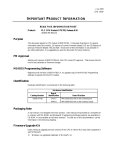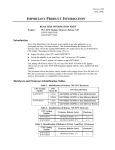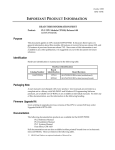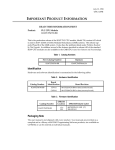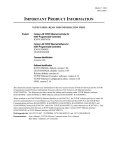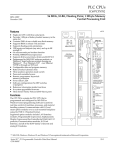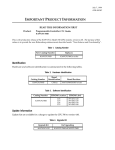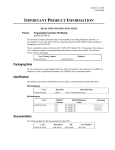Download IMPORTANT PRODUCT INFORMATION
Transcript
Restarts for autonumbers that do not restart in each chapter. figure bi level 1, reset table_big level 1, reset chap_big level 1, reset app_big level 1, reset figure_ap level 1, reset table_ap level 1, reset figure level 1, reset table level 1, reset these restarts must be in the header frame of chapter 1. a:ebx, l 1 resetA a:obx:l 1, resetA a:bigbx level 1 resetA a:ftr level 1 resetA c:ebx, l 1 reset1 c:obx:l 1, reset1 c:bigbx level 1 reset1 c:ftr level 1 reset1 Reminders for autonumbers that need to be restarted manually (first instance will always be 4) let_in level 1: A. B. C. letter level 1:A.B.C. num level 1: 1. 2. 3. num_in level 1: 1. 2. 3. rom_in level 1: I. II. III. roman level 1: I. II. III. steps level 1: 1. 2. 3. February 2001 GFK-1432G IMPORTANT PRODUCT INFORMATION READ THIS INFORMATION FIRST Product: PLC CPU Module CPX782, Release 8.10 IC697CPX782-DD Purpose This document applies to CPU module IC697CPX782. It discusses three topics: (1) general information about this module, (2) features of current firmware release 8.10, and (3) features of previous firmware releases 7.92 and 8.00. Since some of this information is not available in any other publication, it is suggested you save this document for future reference. This document reflects the product catalog number suffix change (from CD to DD) that occurred due to a hardware update of this module. This update does not affect the features, functionality, or compatibility of this product. FM Approval Starting with revision IC697CPX782-BA, this CPU carries FM approval. That revision did not involve any hardware or firmware changes. MS-DOS Programming Software Beginning with revision IC697CPX782-CA, an upgrade copy of the MS-DOS Programming software is packed with the CPU module. Identification Hardware identification is summarized in the following table. Hardware Identification Catalog Number Board Identification IC697CPX782 CPXA1 44A739520-G01 R04 or later (motherboard) HPMB1 44A739564-G01 R01 or later (memory board) Board Revision Packaging Note A user manual is not shipped with every product. User manuals are provided as a complete set in a library with MS-DOS and Windows Programming Software products, are available on CD-ROM, or are available as individual manuals. To order any of this documentation, use the information in the following heading. Firmware Upgrade Kit Users wishing to upgrade previous versions of this CPU to version 8.10 may order Upgrade Kit 44A747754-G03. Windows is a registered trademark of Microsoft, Inc. Important Product Information: PLC CPU Module CPX782, Release 8.10 2 GFK-1432G February 2001 Documentation The following documentation products are available for the IC697CPX782: PLC Reference Manual PLC Installation Manual PLC System Manual Data Sheet, GFK-1431 Full documentation sets are also available in either printed/bound form or in electronic form (CD-ROM). These are listed in the following table. Full Documentation Set Catalog Number Description IC697LBR701* Paper library - full set of printed manuals IC690CDR002* CD-ROM - full set of manuals in electronic format * Current version will be shipped. Special Operation Notes MS-DOS Programming Software Compatibility This release of the CPX782 CPU module is compatible with the versions of MS-DOS programming software listed in the table below. This software supports configuration of the module’s Serial ports, Port 1 and Port 2, and User Flash Memory. However, the MS-DOS programing software does NOT support most of the features new to Release 7 or later CPUs, such as Ethernet Global Data, I/O Scan Sets, VME 3rd Party Interrupts, and Bulk Memory Access (BMA). MS-DOS Programming Software Compatibility CPU Model Software Version IC697CPX782 IC697 Version 7.02 or later Windows Programming Software Compatibility This release of the CPX782 CPU module is compatible with the versions of the Windows based programming software listed below. This software supports configuration of the module’s Serial ports, Port 1 and Port 2, and User Flash Memory, as well as the features new to Release 7 or later CPUs, such as VME 3rd Party Interrupts and Bulk Memory Access (BMA). Software Versions CPU Model IC697CPX782 IC641CTL Version 2.2 or later IC641VPH700 and IC641VPP700 Version 2.0 or later 3 Important Product Information: PLC CPU Module CPX782, Release 8.10 GFK-1432G February 2001 PCM and BTM Compatibility With the introduction of timing improvements and new features first made available in Release 5.00, it is highly recommended that systems using PCMs (Programmable Coprocessor Modules) use IC697PCM711J or later. It is also highly recommended that systems using BTMs (Bus Transmitter Modules) use IC697BEM713B or later. Use of boards of an earlier revision may result in lower system performance. PCM (to CPU) Communications Timeout The PCM has a default backplane communications timeout value of 5 seconds. After the PCM has sent a request to the IC697 CPU, the PCM applies this timeout while waiting on a response back from the CPU. In most cases, the CPU will respond well within the 5–second timeout; however, in certain instances the CPU can take longer than 5 seconds to respond. These cases are limited to LOADs or STOREs of program and/or configuration especially if blocks in the program are larger than 8 KBytes. Folders containing EXE blocks (again with *.EXE files >8 KBytes) are most likely to cause problems. Beginning in Release 6.00, Standalone C programs larger than 8 Kbytes also cause this to happen. Beginning in Release 5.50 of the IC697 CPUs, the CPU is guaranteed to respond within 8 seconds. To ensure that the PCMs do not observe backplane timeouts, a file must be loaded (using termf) to the PCM. The file must be a binary file named CPU.ENV. The contents of this file are as follows (all values are specified in hexadecimal): FILE OFFSET 0000 DATA 4C 5A 01 01 00 00 00 00-00 00 00 00 01 00 00 00 LZ . . . . . . . . . . . . . . 0010 00 00 00 00 00 00 00 00-00 00 43 50 55 4C 49 4E . . . . . . . . . .CPULIN 0020 4B 2E 43 4F 44 00 2D 62-00 36 34 00 2D 74 00 32 K . C O D . –b . 6 4 .–t . 2 0030 30 30 00 00 43 50 55 4C-49 4E 4B 2E 44 43 42 00 0 0 . .C P U L I NK . D C B . 0040 00 4E 55 4C 4C 3A 00 4E-55 4C 4C 3A 00 4E 55 4C . N U L L: . N U L L : . N U L 0050 4C 3A 00 00 00 00 00 00-00 00 00 00 00 00 00 00 L : . . . . . . . . . . . . . . 0060 00 00 00 00 00 00 00 00-00 00 00 00 00 00 00 00 . . . . . . . . . . . . . . . . 0070 00 00 00 00 00 00 00 00-00 00 00 00 00 00 00 00 . . . . . . . . . . . . . . . . Once the binary file CPU.ENV (above) is created, use termf to load CPU.ENV to the PCM. Then execute a soft reset of the PCM. After executing the soft reset, the PCM’s backplane communications timeout should be 10 seconds. Note A copy of the above CPU.ENV file can be obtained from your PLC technical support Internet site. CAUTION The CPU.ENV file will not be used when a hard reset is performed on the PCM. With the CPU.ENV file resident in the PCM, a soft reset must be performed after every hard reset of the PCM. Be aware that it is possible to issue a soft reset COMMREQ from the Ladder Diagram application; therefore, the ap- Important Product Information: PLC CPU Module CPX782, Release 8.10 4 GFK-1432G February 2001 plication can be modified to handle the required reset of PCMs after a power cycle of the PLC system. Notice to Upgrade GBC Hardware With the introduction of new features in CPU Release 5.00, timings with the IC66* Bus Controllers (GBCs/NBCs) changed; this uncovered a problem in the GBC/NBC firmware. GBCs/NBCs in expanded racks could be lost if the system is fully configured and only the main rack cycles power. Also, in previous versions of the GBC/NBC there was a problem with input data coherency. In a system with a long CPU sweep time and a short IC66* bus scan time, a problem could be seen if a device is lost. Input data could be defaulted off while the CPU is reading the data from the GBC/NBC. It is recommended to update existing GBC/NBC hardware to IC697BEM731M or later when updating PLC CPU firmware to Release 7.92. Operation of the IC697BEM731M, in conjunction with Release 7.92 of the IC697 CPU will result in a slight impact to the I/O scan time of the PLC. Third Party VME Modules MS-DOS programming software Release 5.00 (and later) allows 3rd Party VME modules to be configured for six modes: NONE, INTERRUPT ONLY, BUS INTERFACE, FULL MAIL, I/O SCAN, and REDUCED MAIL. However, CPU Release 7.92 does not support REDUCED MAIL. Maximum PLC Sweep In systems configured for IC66* Bus Redundancy, a complete PLC sweep must be executed every 500 milliseconds or less, even though it is possible to configure the watchdog timer to higher limits. This also means that resetting of the watchdog timer with Service Request #8 cannot be done indefinitely. Serial Communications The following operating restrictions exist for the Serial Communications feature: 1. Serial communications can add up to 5 milliseconds of time to any given sweep. This should be taken into account when setting the watchdog timer. 2. The following procedure is recommended if you are using a WSI board and wish to change baud rates for the PLC and the WSI board. First, use the configuration software to change the baud rate on the PLC, then store the new configuration. Next, power off the PLC, then go to the WSI setup screen and change the WSI baud rate. Finally, power the PLC back on. 3. The link idle time setting in the MS-DOS programming software Config for Serial Communications should be set to 10 seconds or greater. Otherwise, a communications failure will occur when storing the config to the PLC. Serial Port Mode Configuration (Applies to Port 3 Only) The Serial Port 3 configuration parameter called MODE can be one of two values: (1) SNP to indicate that the port will be used for SNP communications, or (2) MSG to indicate that Important Product Information: PLC CPU Module CPX782, Release 8.10 GFK-1432G 5 February 2001 the serial port will be used to send printf commands from a C program block to the connected device. If you configure MODE to be MSG and are also using Port 3 to connect to your PLC programmer, communications with the PLC programming software will be lost when going to the RUN mode, since the programming software requires the SNP protocol. In this case, we recommend you use either Serial Port 1 or 2 for communicating with the programming software, since these support only SNP; however, be aware that this capability for Ports 1 and 2 was first made available in Firmware Release 8.00. MS-DOS/WSI Attach Do not connect or disconnect the WSI/BTM cable while the programmer host is powered-on. This action may cause a running PLC to Stop. Expansion Rack ID The expansion racks for the IC697 PLC are shipped with the rack ID strapped for rack 0 (the main rack). If the rack jumper is not changed, the PLC will not recognize the rack at all and may not properly identify the error. Expansion Rack Cable Do not connect or disconnect the expansion rack cable while the CPU is running. This will cause the PLC to go to the STOP/HALT mode. Expansion Rack Power Expansion racks should be powered up at the same time that the main rack is powered up, or they should be powered up after the main rack has completed its power-up initialization. Do not power-up an expansion rack while the CPU is running power-up diagnostics. Memory Usage A general rule-of-thumb for memory usage is 48 bytes per I/O point plus register memory in bytes. Timer Operation Care should be taken when timers (ONDTR, TMR, and OFDTR) are used in program blocks that are NOT called every sweep. The timers accumulate time across calls to the sub-block unless they are reset. This means that they function like timers operating in a program with a much slower sweep than the timers in the main program block. For program blocks that are inactive for large periods of time, the timers should be programmed in such a manner as to account for this catch up feature. Similar to this are timers that are skipped because of the use of the JUMP instruction. Timers that are skipped will NOT catch up and will therefore not accumulate time in the same manner as if they were executed every sweep. I/O Link Interface When powering up the PLC CPU without a battery, and I/O Link Interface boards are present, an incorrect Loss of Module fault will be logged for each I/O Link Interface board. The PLC CPU will not consider these boards as lost, and the boards will continue to operate properly. 6 Important Product Information: PLC CPU Module CPX782, Release 8.10 GFK-1432G February 2001 CommReqs with Retentive Memory When powering up the PLC CPU with a program being retrieved from Retentive Memory and proceeding to RUN mode, any CommReqs to a PCM should be delayed for 5 seconds. Constant Sweep Constant Sweep time, when used, should be set to about 10 milliseconds greater than the normal sweep time to avoid any oversweep conditions when monitoring or performing on-line changes with the programmer. The smallest valid constant sweep time setting is 10 milliseconds for the Model CPX782 PLC. Window completion faults will occur if the constant sweep setting is not high enough. Interaction of MS-DOS Programming Software with Closed Programming Window The MS-DOS programming software PLC Sweep Control and Monitor screen cannot be used to change the PLC Sweep Modes or timers (Constant Sweep Time, Program Window Times, etc.) while the program window is closed. Use Service Requests #1 through #4 to perform these functions. Caution The MS-DOS/Windows programming software cannot be used to change the PLC mode (STOP/RUN, etc.) while the programming window is closed. Use the toggle switch on the CPU module instead. Model CPX782 CPU Ambient Temperature Under worst case conditions, at temperatures above 50 degrees Celsius, some limiting of system power may be necessary. Please see the data sheet for this product (IC697CPX782) for more information. SFC RESET Function Block The SFC RESET function block only executes when used in Action Logic or Pre/Post Logic within an SFC block (Main SFC or SFC sub-block). Attempting to execute an SFC RESET function block from a Ladder Diagram Main/sub-block will not reset the SFC network, and (as of version 6.02) will not pass power flow to any logic right of the SFC RESET. Ethernet Global Data and Sweep Time Each Ethernet Global Data exchange configured for either consumption or production can add up to 1 msec to the sweep time. This sweep impact should be taken into account when configuring the PLC constant sweep mode and setting the CPU watchdog timeout. Serial Ports 1 and 2 This CPU is equipped with two additional serial ports (Ports 1 and 2) as well as the standard serial port (Port 3) found on previous IC697 CPU models. Port 1 supports the RS-232 standard, and Port 2 supports the RS-422/485 standard. These additional serial Important Product Information: PLC CPU Module CPX782, Release 8.10 GFK-1432G 7 February 2001 ports support the following baud rates: 1200, 2400, 9600, 19200, 38400, and 57600. Note that they do not yet support 115K baud. Both ports can be operated simultaneously without dropping characters up to 57600 baud. SNP Slave protocol support for these ports was added in Firmware Release 7.80. Break-Free SNP (Slave) was added as the default protocol to Ports 1 and 2 in Firmware Release 8.00 (Serial Port 3 does not support Break-Free SNP). All functionality of Serial Port 3 is available through Ports 1 and 2 with these exceptions: (1) they do not support connection of the C debugger, (2) they do not support printf functionality using C programming, (3) Datagram memory sizes may be different. See the item “Datagram Memory Sizes” in this section. All three serial ports can be configured by both MS-DOS and Windows programming packages for selecting baud rate, parity, stop bits, etc. If upgrading this module from a previous version that did not support these two ports, you may have to set up the ports’ configuration parameters (using a programmer connected to Port 3) before you will be able to use the ports. Programmer Communications Issues (Serial Ports 1 and 2) When using Serial Ports 1 or 2 for programmer communications, a momentary loss of communications may be observed after a store of hardware configuration while configuration settings are being updated. This is normal operation. Note that all port communications settings should be carefully verified before performing a hardware configuration store. If any of the essential configuration settings (such as mode, baud rate, parity, etc.) for the port connected to the programmer are changed, you will lose communications after a configuration store. Communications will be restored once the host (programmer) settings are changed to match the port’s new settings. Word–Wide Reads from a Third Party VME Module If an attempt to read a word value from a third party VME module that does not support word–wide accesses occurs, and the module responds to a GE Fanuc slot–assigned address, the module will generate a System Bus Error fault. 1. The 90–70 CPU always interrogates the first several bytes of every GE Fanuc slot assignment using word accesses during system configuration. 2. If the user sees a System Buss Error fault in this situation (a third party module that does not support word–wide access is present and responds to a GE Fanuc slot assigned address and asserts bus error), then the user should ignore it. Designers of applications that use such modules should also instruct their users to ignore this fault. 3. To avoid this System Bus Error fault, designers of third party VME modules that do not support word–wide accesses may do one of the following: A. Configure the VME base address of the module such that it is not at the beginning of the address space for any GE Fanuc slot assignment. Using a base address in the range 100000 – 7FFFFF (hex) is ideal for this. Another option is to use AM code 3Dh instead of 39h or 29h. B. Configure the VME module such that it does not assert a bus error (BERR). It would be better if the VME module did not respond at all to these word–wide accesses. One possible way to fix this is to disconnect the BERR line from the Important Product Information: PLC CPU Module CPX782, Release 8.10 8 GFK-1432G February 2001 module (which will force it high), assuming the module will not also assert DTACK for these word–wide cycles. User Flash Memory The CPX772 board supports a user flash memory option which allows you to store program logic, configuration data, reference tables, passwords, and the OEM key to the flash memory device located on the CPX772. This feature supports the current flash memory operation available on the IC697CPU782 with 256K flash memory daughterboard. CMM and PCM Module Compatibility Due to the increased reference table sizes on the CPX CPU models, older versions of CMM and PCM modules may experience compatibility problems with the CPX model CPUs. Firmware upgrades are available for customers with other versions of these modules. CMM modules (IC697CMM711) of revision ’F’ or later will not experience this problem. PCM modules (IC697PCM711) of revision ’F’ or later will not experience this problem. Datagram Memory Sizes The number and sizes of datagrams established using Serial Ports 1 and 2 may be different that those of Serial Port 3. This is because the memory spaces allocated for datagrams for Ports 1 and 2 are fixed sizes, but Serial Port 3 shares its datagram memory space with hardware configuration data. Therefore, the Port 3 datatgram memory allocation may be larger or smaller than Ports 1 and 2 depending on the amount of configuration data required by the system. Problems Resolved by this Firmware Release (8.10) Incorrect Checksums from Service Request 23 Service Request 23, which returns checksums, does not include the checksums from all of the configuration units and sometimes returns the incorrect value for the program checksum. COMM_REQs Located in Interrupt Blocks If the target of a COMM_REQ used in an interrupt block is a smart option module, the COMM_REQ may fail and cause a CPU software fault. PSB Power Flow Output The Power Flow out parameter from a Parameterized Subroutine Block (PSB) may be overwritten by a call to another PSB if the parameter is set prior to the call of the subsequent PSB. PSB Y0 Not Saved and Restored Across Calls to Nested PSBs PSB Y0 is not saved and restored across calls to nested PSBs (Parameterized Subroutine Blocks). A single location in bit cache memory is used for storing the Y0 value, and this Important Product Information: PLC CPU Module CPX782, Release 8.10 GFK-1432G 9 February 2001 bit is set to “1” upon each invocation of a PSB block. Use a different variable to store the value of Y0 across the call and set Y0 immediately prior to exiting the block. Care should be taken when using Y0 both within a PSB block called by an interrupt block and in the block called by the main LD program. Problems Resolved by Previous Firmware Release 8.00 None to report. Problems Resolved by Firmware Release 7.92 1. The CPU would fail if Loss of Module or System Configuration Mismatch faults were logged against an Ethernet module. This failure only occurred if point faults were enabled in the CPU and the status word for the Ethernet Module was configured for %R memory. 2. Large FBC Configuration Files (more than 4K bytes) were not being transferred completely on powerup. 3. User Flash Operations for the CPX CPU boards could not be used when an Ethernet Adapter board was in the system. Doing so would result in failure of the PLC CPU. 4. The masked compare function block did not operate correctly when the first input parameter (first bit string) was not aligned on a word boundary (for example, %M0009 instead of %M0017). Using the masked compare function block in this way would access a byte in memory just before the MASK parameter resulting in an incorrect mask being applied on an invalid memory access. 5. When Run Mode Store is used to delete programs and more than 8 programs exist in the PLC, the subsequent Run Mode Store operations that add programs can sometimes result in one of the programs being deleted. 6. The total program logic size returned by the PLC to the Programmer, when at least one C Program Block is defined, is incorrect. 7. The size of Standalone C programs reported in the Program Memory screen of the IC697 MS-DOS Programming Software is too large by about 500 bytes. Therefore, this screen may indicate that a Standalone C program slightly larger than the program limit has been stored to the PLC CPU. 8. Application changes with more than 200 program blocks in CPU: The CPU now correctly returns the list of stored program blocks when more than 200 program blocks (including _MAIN) are used. Previously, an invalid list was returned which could cause attempts to Run Mode Store via Ethernet to fail resulting in the MS-DOS Programming Software to continuously report ”BUSY.” Likewise, a store of hardware configuration without also storing the Logic Program sometimes failed if the CPU already contained more than 200 program blocks. In both of these cases, the original Logic Program and Hardware Configuration remained intact in the CPU and control was unaffected. Programs having fewer than 200 program blocks did not manifest this problem. Also, releases prior to Release 7.00 did not have this problem. Important Product Information: PLC CPU Module CPX782, Release 8.10 10 GFK-1432G February 2001 As of the date of this CPU release, the Host Communications Toolkit (HCT) still has a problem with more than 200 program blocks. HMI and other software packages that use the HCT to obtain the list of program block names from the CPU may experience communication failures when the application has more than 200 program blocks. New Features and Functionality of this Firmware Release (8.10) Increased Maximum %R Size Increased the maximum size of the register table from 16384 to 32640. This feature requires version 2.0 or later of the IC641VPH/VPP software. TOD Clock Changed The default time–of–day (TOD) clock has been updated to January 1, 2000 Service Request 7 Given POSIX Capability Service Request 7 supports reading or writing the Real Time Clock in POSIX format. This feature has been available since 7.90, but was previously undocumented. To use this request, the following data block must be included : Data Memory Location 0 = Read time and date 1 = Set time and date Address* 4 = POSIX format (see manual for other formats) Address + 1 Number of seconds (signed double word value). Address + 2 Number of nanoseconds (signed double word value) Address + 4 * Address refers to the first word of the data block. For example, if Address were %R00100, Address + 1 would be %R00101, Address + 2 would be %R00102, and Address + 4 would be %R00104. New Features and Functionality of Previous Firmware Release 8.00 Enhanced Functionality of Serial Ports 1 and 2 Serial Ports 1 and 2 now support “break-free” SNP. Break-free SNP improves serial communication using modems. The break-free implementation of the SNP protocol does not rely on receiving serial breaks. Consequently, modem pairs that alter the timing or characteristics of breaks from SNP masters may be used successfully. Note that break-free is now the default mode of operation for the SNP protocol on these two ports. Break-free operation is completely transparent. When normal breaks are received, SNP communication is identical to previous releases. However, Attach messages are also recognized without a preceding break. Modified breaks (for example, breaks transformed to a single ASCII NUL character with or without a framing error) are ignored. Serial Ports 1 and 2 now fully support programming using either the DOS or the Windows programming software, including the program upload, download, and data monitoring features. See the note below for programming limitations. 11 Important Product Information: PLC CPU Module CPX782, Release 8.10 GFK-1432G February 2001 Note Serial Ports 1 and 2 do not support connection of the C debugger or printf functionality using C programming. New Features and Functionality of Previous Firmware Release 7.92 1. Clock Synchronization using FIP and/or SIO Module. The Clock Synchronization feature allows the user to synchronize the CPU’s Time-of-Day clock to a master clock external to the CPU. Two types of synchronization are supported: a) External Clock Synchronization which synchronizes based on a timestamp from the FIP network that identifies the point at which a signal is sent to the SIO module, and b) Network Clock Synchronization where the time is synchronized using the FIP network. 2. Multi-threaded LD Program Capability (MTLD). The MTLD feature allows you to have, in effect, multiple LD programs by giving C programs the ability to call LD blocks in the LD program. 3. Run Mode Store in Microcycle Sweep Mode. Run Mode Store is now permitted when in microcycle mode. Programs are swapped at a point where no programs are executing in the system. 4. Read/Write of PLC CPU Memory using Service Request Function Block. Selected memory types can be read or written using a new service request function block. The list of memory types is limited to Bulk Memory, FIP Specific Information, and the BCP direct cache. 5. Bulk Memory Access (BMA). BMA provides a large block of memory that can be accessed from your application program. Possible uses include recipe files, bulk storage, memory allocation, temporary memory blocks, etc. Use of this feature requires the IC641CTL software version 2.2 or later (or IC641VPH/VPP version 2.0 or later). (The DOS programming software does not support it.) Enhancements to the on-line help for this feature were added to this software in version 2.3. 6. C Toolkit Enhancements. Version 5 of the C Toolkit supports access to BMA (feature 5 above) and supports MTLD (feature 2 above). Restrictions and Open Problems 1. If an expansion rack powers up while the CPU in the main rack is in the RUN mode, the slot fault contacts will prematurely indicate that the modules in the expansion rack are not faulted before they complete their power up. 2. When there is no logic stored in a CPU module, the %Q and %M tables will be cleared when the CPU is placed in RUN mode. In this context, no logic stored means that no program had ever been stored or that the clear function on the MS-DOS programming software had been used to clear logic and configuration. 3. When the Bit Sequencer sequences from one step to another, the negative transitional contact that corresponds to the original step is not set. The transition contact for the new step is set and remains set until the sequencer sequences to the next step. This operation is identical to the operation of the previous versions of the CPU firmware. 4. If multiple faults exist in an IC697 PLC remote drop and one of them is corrected, a FAULT contact that uses the remote drop’s module reference will incorrectly indicate that no faults exist at the remote drop. Important Product Information: PLC CPU Module CPX782, Release 8.10 12 GFK-1432G February 2001 5. An incorrectly formatted COMMREQ (for example, incorrect task id field) directed to a PCM or CMM module does not result in an error being logged in the PLC fault table. Correctly formatted COMMREQs operate normally. 6. The bit sequencer function block clears bits outside the range of the function’s length parameter when the reset condition is TRUE. The affected bits lie within the bytes accessed by the function. For example, with length 100 (bits), the four bits at 101, 102, 103, and 104 are cleared by the bitseq function when it is reset. This operation is identical to the operation of the previous versions of the CPU firmware. 7. A large number of COMMREQs (typically greater than 8) sent to a given board in the same sweep may cause a Module Software fault to be logged in the PLC fault table. The fault group is MOD_OTHR_SOFTWR (16t, 10h) and the error code is COMMREQ_MB_FULL_START (2). When this occurs, the FT output of the function block will also be set. To prevent this situation, COMMREQs issued to a given board should be spread across multiple sweeps so that only a limited number (typically 8 or less) of COMMREQs are sent to a given board in each sweep. In addition, the FT output parameter should be checked for errors. If the FT output is set (meaning that an error has been detected), the COMMREQ should be re-issued by the application logic. 8. When attempting simultaneous loads of logic through multiple ethernet connections and a serial connection, the loads through the ethernet connection may fail with a communication timeout. 9. On occasion, the PLC may fail to respond to an SNP Attach message issued through Serial Ports 1 or 2. Several retries of the SNP Attach message may be necessary to successfully attach to the PLC via these two ports. Therefore, users developing their own SNP applications to run on these two ports should design and code for multiple SNP Attach retries. 10. If an attempt to read a word value from a third party VME module that does not support word wide accesses occurs, and the module responds to a GE Fanuc slot–assigned address, the module will generate a System Bus Error fault. Please see the “Special Operation Notes” section for more information on this issue. Additions to the PLC Reference Manual None.












